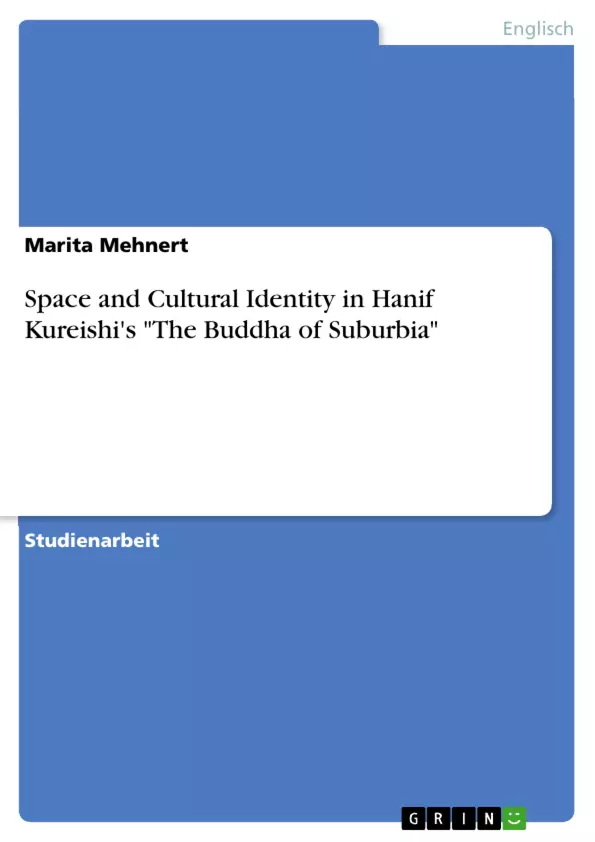This term paper uses a postcolonial approach to analyse Karim's movement between the city centre and the suburbs in "The Buddha of Suburbia". These spatial relations reflect on his development of a culturally hybrid identity that goes beyond the simple British-Indian dichotomy. It moves on from a binary view of belonging either to the one or the other to a more differentiated understanding of the fluid, fragmentary and hybrid nature of the protagonist’s postcolonial identity.
The novel follows the journey of the protagonist, Karim, as he navigates through different spaces in London, ranging from the suburbs, the home of his biracial family, to the inner city. All while grappling with his quest for a 'true' identity. Set in the 1970s, just after the post-World War II influx of immigrants from former British colonies. The narrative is shaped by the socio-political backdrop of the time, marked by the Commonwealth Immigrants Acts of 1962 and 1968, which restricted the entry of Commonwealth citizens.
The spatial relations in the novel mirror a center-periphery dynamic akin to colonial British-Indian relations. The suburbs symbolize the diaspora and marginalized regions and populations, while inner London represents the epitome of power, wealth, and social and cultural achievements. Karim's movement between these spaces parallels his cultural identity's evolution, transcending the simplistic British-Indian dichotomy. The narrative progresses beyond a binary view of belonging to either one culture or the other, illustrating a more nuanced understanding of the fluid, fragmentary, and hybrid nature of the protagonist’s postcolonial identity.
Informed by Stuart Hall's cultural studies, the novel rejects the concept of distinct, complete, and coherent identities. Instead, identity is portrayed as fluid, a work in progress marked by fragmentation and defined by differences from other identities. These differences are shaped by the characteristic binaries of dominant and subordinate identities, reflecting the complexities of Karim's journey towards a multifaceted and evolving sense of self.
Inhaltsverzeichnis
- Introduction
- Life in the Diaspora
- Striving for the Centre
- Fragmentation of Identities
- Conclusion
Zielsetzung und Themenschwerpunkte
Der Text analysiert die Entwicklung der kulturellen Identität des Protagonisten Karim Amir im Roman "The Buddha of Suburbia" von Hanif Kureishi, indem er die räumlichen Verhältnisse des Romans in Bezug auf die postkoloniale Identität und die Fragmentierung von Identität untersucht.
- Postkoloniale Identität und die Erfahrung der Diaspora
- Räumliche Metaphern des Zentrums und der Peripherie
- Hybridität und Fragmentierung der Identität
- Stereotypisierung und Orientalismus
- Die Auswirkungen von Kolonialismus und Rassismus auf die kulturelle Identität
Zusammenfassung der Kapitel
Introduction
Die Einleitung stellt den Roman "The Buddha of Suburbia" und den Protagonisten Karim Amir vor, dessen Suche nach seiner Identität im Mittelpunkt des Romans steht. Der Text argumentiert, dass Karim's Reise durch London, von den Vorstädten ins Zentrum der Macht, mit der Entwicklung seiner kulturellen Identität verbunden ist. Die Einleitung beleuchtet auch den historischen Kontext des Romans in den 1970er Jahren, mit dem Zustrom von Einwanderern aus ehemaligen britischen Kolonien und dem Anstieg von Rassismus und Diskriminierung.
Life in the Diaspora
Dieses Kapitel untersucht die Darstellung der Diaspora im Roman, wobei der Fokus auf den Einfluss von Edward Said's Theorie des Orientalismus liegt. Das Kapitel zeigt, wie die stereotypen Vorstellungen von "Orient" und "Westen" die Identitätskonstruktionen von sowohl weißen Briten als auch der Einwanderer beeinflussen. Es wird argumentiert, dass die Erfahrung des Rassismus und die Versuche, sich in die weiße britische Gesellschaft zu integrieren, Karim und seinen Vater dazu zwingen, mit stereotypischen Erwartungen und Vorurteilen umzugehen.
Schlüsselwörter
Die Schlüsselwörter des Textes beinhalten: postkoloniale Identität, Diaspora, Orientalismus, Hybridität, Fragmentierung, Stereotypisierung, Zentrum und Peripherie, Raum, Kultur, Rassismus, Kolonialismus, "The Buddha of Suburbia", Hanif Kureishi.
- Citation du texte
- Marita Mehnert (Auteur), 2019, Space and Cultural Identity in Hanif Kureishi's "The Buddha of Suburbia", Munich, GRIN Verlag, https://www.grin.com/document/1000153




